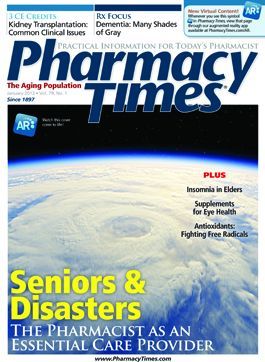How the Clot Factors
New treatments for stroke prevention in atrial fibrillation require patient-specific assessment.

New treatments for stroke prevention in atrial fibrillation require patient-specific assessment.
It is no secret that nonvalvular atrial fibrillation (NVAF), the most common arrhythmia, currently impacts more than 2.6 million adults in the United States, and as many as 12 million patients older than 65 years are predicted to develop the condition by 2050.1 With the rapid growth of our aging population and with stroke being the fourth leading cause of death in the United States, awareness has become a cause worth championing.
Within the past 3 years, we’ve been introduced to a few therapeutic alternatives to warfarin for the management of stroke prevention in AF (SPAF), namely dabigatran (Pradaxa), rivaroxaban (Xarelto), and apixaban (Eliquis). Recent trials have revealed safety and efficacy in SPAF; however, despite these results, potential for bleeding remains a concern.
Armed with more options for outpatient management of AF and validated assessment tools to better assess patient risks, we are on our way toward better management of a rapidly growing population of AF patients.
Patient Assessment: The Anticoag “ClotBox”
Anticoagulation is not “one-size-fits all.” Patient-specific factors should be taken into consideration when assessing the risk versus benefit of anticoagulation initiation. Validated clinical mnemonic devices, such as the CHADS2 score, a predictive rule used to estimate stroke risk in AF patients, and the HAS-BLED score, used to assess a patient’s risk of bleeding, may be helpful clinical decision-making tools.2,3
Patient Management: Warfarin, Novel Anticoagulants, and Bleeding
For more than half a century, the only oral anticoagulant option in the United States was warfarin. After being the mainstay for SPAF management and with the introduction of “second-generation” anticoagulants, what role does warfarin play in 2013?
With the second-generation oral anticoagulants dabigatran and rivaroxaban on the market and the recent approval of apixaban comes the common controversy that surrounds anticoagulants: bleeding. You may have noticed the increased direct-toconsumer advertising campaigns surrounding management of NVAF. Juxtaposed to those campaigns are mass tort suits advising patients to call 1-800-BAD-DRUG and other media outreach targeting patients who have suffered severe bleeding events after taking dabigatran. The following represent some frequently asked questions that patients— and pharmacists—may have.
Are the novel anticoagulants “bad drugs”?
No. Recently, there has been discussion that bleeding rates are not accurately depicted in the clinical trial setting, as patients in this setting receive more frequent intervention by physicians, pharmacists, and other health care professionals, thus suggesting that these novel agents would not cause the moderate amount of bleeding represented in their respective trials. As an answer to these campaigns and the other scrutiny, the FDA Advisory Panel conducted post-marketing surveillance on dabigatran and recently reported that bleeding upon initiation of the novel agent does not appear to be greater than bleeding associated with that of warfarin, thus in alignment with the findings of the pivotal RE-LY trial.4,5
Should warfarin go to the wayside?
No. It is a well-known fact that bleeding is a cause for concern with warfarin; however, in a large study conducted in Canada by Gomes et al, it was suggested that “real world” major bleeding events with warfarin often lead to slightly more fatal outcomes than previously found in trials. As expected, this study confirmed that those aged 75 years or older at the start of treatment yielded a higher risk of hemorrhage [4.6% (95% confidence interval 4.5%-4.7%)], while also showing higher bleeding rates with advanced age (≥75 years) and increasing CHADS2 score.6
Balancing Risks and Benefits
All anticoagulants have the potential to increase bleeding. Not enough “real world” data exist to draw firm conclusions related to the rate of hemorrhage with the novel agents. Each of the aforementioned agents remains an option for SPAF. The optimal choice of agent should depend on patient-specific assessment.
Dr. Stevens is an advanced practice anticoagulation pharmacist for the Partners Heathcare System and an adjunct clinical assistant professor of pharmacy at Northeastern University’s Bouvé College of Health Sciences in Boston, Massachusetts. This column’s information is based on current studies and references, but it may be changed without notice with newer studies or with different populations.
References
- Lloyd-Jones D, Adams RJ, Brown TM, et al. Heart Disease and Stroke Statistics—2010 Update: a report from the American Heart Association. Circulation. 2010;121:e91.
- Gage BF, Waterman AD, Shannon W, Boechler M, Rich MW, Radford MJ. Validation of clinical classification schemes for predicting stroke: results from the National Registry of Atrial Fibrillation. JAMA. 2010;285(22):2864-2870.
- Pisters R, Lane DA, Nieuwlaat R, et al. A novel user-friendly score (HAS-BLED) to assess 1-year risk of major bleeding in patients with atrial fibrillation: the Euro Heart Survey. Chest. 2010;138(5):1093-1100.
- FDA Drug Safety Communication. Update on the risk for serious bleeding events with the anticoagulant Pradaxa (dabigatran). www.fda.gov/Drugs/DrugSafety/ucm326580.htm. Published November 2, 2012. Accessed December 7, 2012.
- Connolly SJ, Ezekowitz MD, Yusuf S, et al. Dabigatran versus warfarin in patients with atrial fibrillation. N Engl J Med. 2009;361:1139-1151.
- Gomes T, Mamdani MM, Holbrook AM, et al. Rates of hemorrhage during warfarin therapy for atrial fibrillation [published online November 26, 2012]. CMAJ. doi:10.1503/cmaj.121218.

